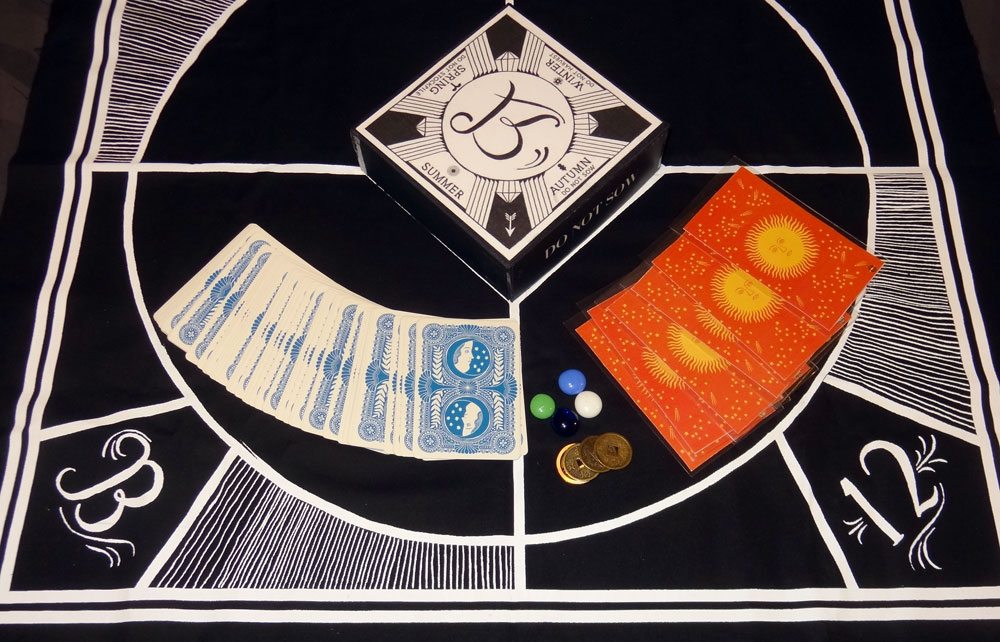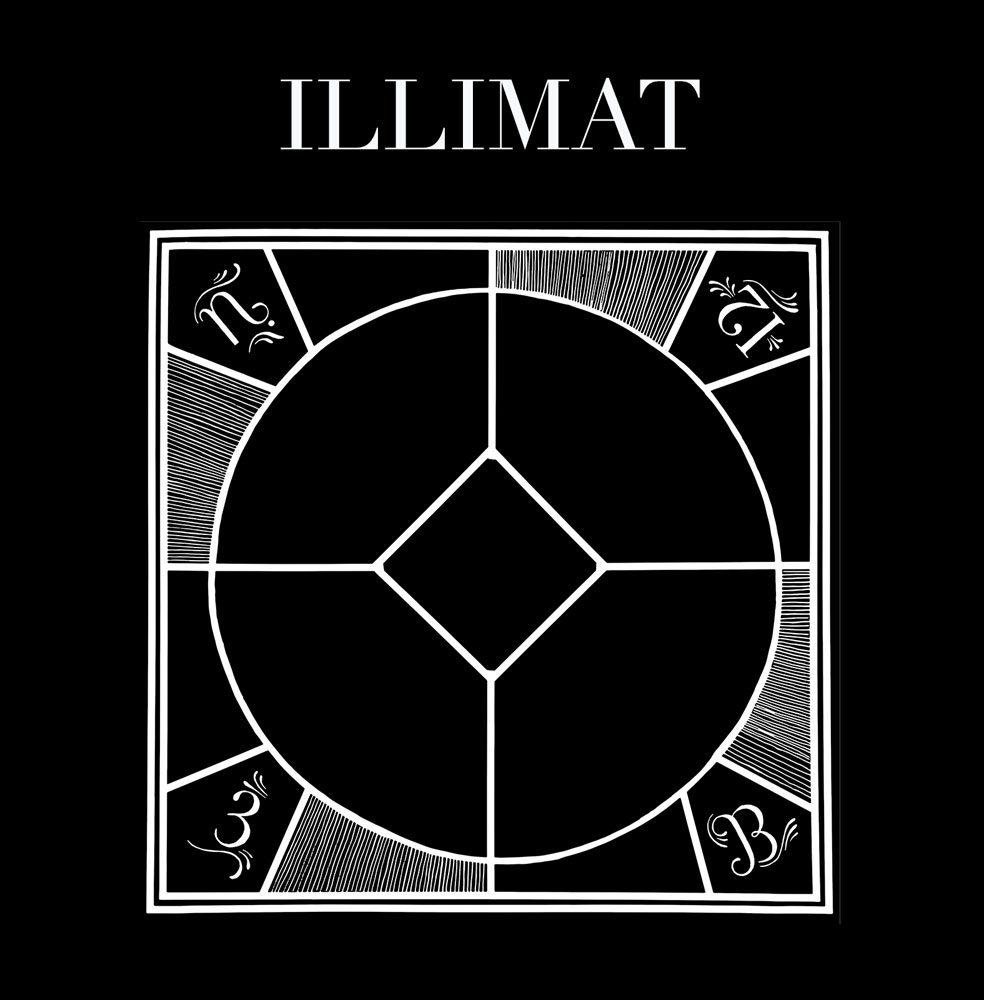Today you are presented with a rare opportunity, to join the Society of Luminaries and learn the esoteric custom known as Illimat.
At a glance: Illimat is a card game by Keith Baker and the Decemberists for 2 to 4 players and takes about 15 minutes per hand. (You can play a single hand of it, or to a particular point goal.) It just launched on Kickstarter today, and is available for a pledge of $45 (or $55 if you want the Society of Luminaries initiate pin). The gameplay is inspired by classic card games and is not too complex to learn, and there isn’t anything inappropriate for younger players. I didn’t see a recommended age range, but I think probably 8 and up would be okay—there’s a little bit of arithmetic involved.
New to Kickstarter? Check out our crowdfunding primer, and visit our curated page for more projects we love.
The Story
Normally I just jump right into components, then gameplay, and then my opinion of the game, but Illimat has an interesting story behind it that I think would make a good preamble, because it informs the way the game looks and how it plays. (The story is also reenacted in the Kickstarter video.) The Decemberists, in case you were unaware, are an indie band from Portland, Oregon. Lead singer Colin Meloy is also the author of the Wildwood trilogy, which was illustrated by his wife Carson Ellis, who also has done a lot of the band’s album artwork and promotional art. Oh, and the Decemberists love playing games and spend a lot of time gaming together when they’re on tour.
A few years ago, the band had an idea for a photo shoot: they wanted to get photos of themselves playing a mysterious board game in various locations, as if they were part of a secret society and this was some sort of obscure ritual. Ellis and photographer Autumn de Wilde made up a board with a little box on it and some cards, and (from what I was told) they only ended up using it for one photo shoot rather than all over Portland. The board sat there for a long time, though, and eventually they wondered if they could make an actual, playable game to go along with it.

Enter Keith Baker. Baker is the designer of the Eberron setting for Dungeons & Dragons as well as the card game Gloom, and it was the latter that eventually connected him to the Decemberists. Guitarist Chris Funk and his daughter were fans of the game, so they got in touch with Baker, a fellow Portlander. One thing led to another, and they asked Baker if he would be interested in developing a game with them.
Baker’s challenge was to create a game to be played on a board that had been designed without actual rules to work with, and there was a little box that sat on top of the board, which would need to be worked into the game somehow. (The photo showed the band using cards with single letters on them, but those did not make it into the final game.) The Decemberists wanted something that could exist in the world of their album “Hazards of Love,” without the game being about the album. They wanted it to feel like a game that you might have discovered in your grandparents’ attic, something with a timeless feel. In keeping with the secret society idea, Baker wanted the game to feel a little mystifying to somebody who was just casually watching, but at the same time not too complex to learn.
Illimat is the result of this collaboration. So cue up “Hazards of Love,” put on your best formal attire, and get your secret handshake ready … it’s time to play.

Components
- 1 fabric board
- 1 Illimat box
- 65 cards
- 8 Luminary cards
- 4 okus tokens
- 4 scoring tokens
The board itself is a black fabric with white paint: it has four “fields” surrounding the center, which has a square to fit the box. The four corners of the board are marked with symbols, though they actually don’t serve a particular game function. There will also be a scoring track around the outer edge of the board (not on the prototype).

The cards are similar to a poker deck, except that there are five suits total: the four seasons, plus stars, which are only used in a 4-player game. Like a regular poker deck, each has 13 cards total: numbered cards from 2 to 10; plus some Court cards—Knight, Queen, King, and a Fool, replacing the Ace, which counts as a 1 or a 14.

Each of the Court cards has a custom illustration—the Knights all have similar poses, but slight differences between the suits. The illustrations are lovely and definitely look like they are from an earlier time. The card backs were also illustrated by Ellis—these will be black ink in the final game rather than blue as seen in my photos of the prototype.

The Luminary cards are tarot-sized cards, and each of these features another piece of Ellis’ artwork, with a name like “The River” or “The Rake” or “The Changeling” but no other text. There’s a summary card that explains what each of the Luminaries does, but the cards themselves do not have game text on them, partly to keep that element of mystery in the game.

The box that sits in the center of the board has the four seasons marked on the four edges, and an imaginary letter of some sort in the center. Along the sides of the box are printed phrases like “Do Not Sow,” corresponding to the seasons. One nice touch is that the game actually fits into this box, thanks to the fabric board, so it is both a game component and the storage itself. The box design isn’t totally finalized yet, but Baker said that they’re considering making the box bottom the same thing but without any words, just the season icons. Also, the idea for retail is that there would be a sleeve or overlay explaining the game, but once you’ve purchased the game and have it on your shelf, you could have this enigmatic box that says very little about what it actually is.
The okus tokens will be some small objects (rather than the Chinese coins or glass beads seen in my photos), but these have not been finalized yet. The scoring tokens will be something akin to Go stones.

How to Play
The goal of the game is to score the most points by harvesting cards, okus tokens, and Luminaries. You can play a single hand, or continue playing hands until somebody reaches a set goal of 12 points or 17 points, depending on the length of game desired.
To set up, place the board on the table so that each player is sitting along an edge of the board (not the corners). The Illimat is placed in the center of the board, with the arrow pointing toward the dealer, and place one okus token per player on the Illimat. Shuffle the cards (include the Star suit only in a 4-player game) and deal three cards into each of the four fields on the board, and then deal four cards to each player (except the starting player, who only receives three cards). Shuffle the Luminary cards and place one face-down in each of the four corners of the board.

On your turn, you must choose a field and play exactly one card from your hand. Your card must be played to Sow, Harvest, or Stockpile.
Sow: Discard your card face-up into the field.
Harvest: Collect any cards that match the value of your card, either individually or as sums. Cards you collect (and the card you played to Harvest) are set aside face-down in your own harvest pile. As an example, you could play an 8, and then pick up an 8, and a 5 and a 3 together, as long as they were all in the same field.
If you pick up the last card in the field, you take an okus token (if there are any left). If the Luminary for that field is face-down, you turn it face-up—it is now active. If the Luminary was already face-up, you claim the Luminary. If there are enough cards left in the deck after claiming an okus or turning a Luminary face-up (or both), then deal three more cards into the field. Some Luminaries trigger as soon as they are revealed, and some trigger only if they are claimed.
Stockpile: Combine your card with at least one other card in the field, creating a stack of cards that may only be harvested together rather than individually. It can be a stack of several of the same card (two 9s) or it can be cards added to form a new value (3 and 4 to make a 7). (Turn stacks or cards at right angles to indicate they are separate values rather than sums.) You must have a card in your hand that matches the value of the stack you are creating in order to Stockpile.
Once you’ve taken your action, draw back up to four cards.
The Illimat indicates which season is affecting each of the four fields, and affects certain actions:
- Winter: you may not Harvest.
- Spring: You may not Stockpile.
- Autumn: You may not Sow.
(Summer has no restrictions.) Whenever a Court card is played, resolve the action, and then rotate the Illimat so that the season of the field affected matches the season of the card that was played. When a Star suit Court card is played, the player may choose which season to turn it to.
The hand ends when everyone has played all of their cards and there are no more to be drawn from the deck. Any cards on the board that were not harvested (including Luminaries) are discarded, and score points as follows:
- Cornucopia: The player with the most cards gets 4 points
- Sunkissed: The player with the most Summer cards gets 2 points
- Frostbit: The player with the most Winter cards loses 2 points
- Each Fool, Luminary, and okus is worth 1 point
If there are ties for most cards, the tie goes in favor of the player with the most Luminaries (so for Frostbit, the player with fewer Luminaries will lose the points). If there’s still a tie, nobody gets the points. Victory goes to the player with the most points, or (as chosen beforehand) to the player who reaches the goal first.

The Verdict
I first saw a prototype of Illimat last December. Many of the elements were already there: the board and box, the season-based suits, the three primary actions. However, the game and the look have gotten a lot of tweaks and adjustments since then, and it’s pretty polished. Keith Baker and Jenn Ellis of Twogether Studios ran demos of it at PAX West in Seattle and XOXO in Portland this fall and have gotten a pretty good reception.
Baker has definitely succeeded in his goal of making a game that has a timeless feel to it. The core of the game is based on a traditional card game called Casino—I grew up playing a variant of it with my grandmother, so the rules have a familiar feel to them. But the four fields and the seasons are new: the restrictions on actions in particular seasons adds an interesting wrinkle, and yet it still feels like the type of game that somebody could have designed a century ago and just discovered recently. And, of course, it’s also a beautiful game and wouldn’t look out of place in a speakeasy concealed behind a bookshelf, or maybe in one of Miss Peregrine’s peculiar loops. The optional initiate pins are a nice touch—something that pull Kickstarter backers a little further into this “secret society.”
The game also has a slightly different feel depending on how many players you have. Two-player games are more strategic, because you only have one opponent and the various scoring mechanisms are a zero-sum game. You can easily calculate, for example, whether it’s worth taking the last Winter card—will it give you the Cornucopia bonus? Will it make you Frostbit? Bump it up to four players, though, and the state of the board can change significantly by the time it’s your turn. If you Stockpile some cards in a field, there are three opportunities for another player to Harvest them before you get a chance. It’s not total chaos, but it does become a little more random. If you prefer more strategy, the 2-player game may be more your speed, but if you prefer a bit of unpredictability, play a 4-player game. The 3-player game is a good balance of the two.
Normally I want a game to be as self-explanatory as possible: cards should say what they do (or have icons that are easily interpreted), the board should be legible and intuitive, and so on. However, Illimat is intended to look like something from a secret society, with rituals and traditions that are hidden from the uninitiated. As such, it makes sense thematically for the Luminary cards to have no game text other than a title, and for there to be random letters and numbers on the board that have no actual game function. I also really like the idea of a second Illimat that does not have text on it, just the season symbols, so that once you get used to the game, you can make it even more mysterious. That said, I do hope that those who play Illimat are quick to invite people in on the secrets, because I like the idea of tabletop games as accessible rather than arcane, even the ones that are thematically arcane.
With all the fancy new games that are being released these days, I actually don’t spend much time playing traditional card games anymore, which means that my kids, although they get to experience really amazing games that weren’t around when I was a kid, don’t know how to play many of the card games that I grew up with. Illimat may be a cool way to pique their interest (or revive my own) in those types of games.
If you like lovely, intriguing games, Illimat may fit the bill. Visit the Kickstarter page for more information and to make your pledge.






As a Decemberist fan, how can I not back this?
Can’t wait to give it a try.
I love the Hazards of Love album, though track 10 is about killing your children, which GeekDad doesn’t endorse!